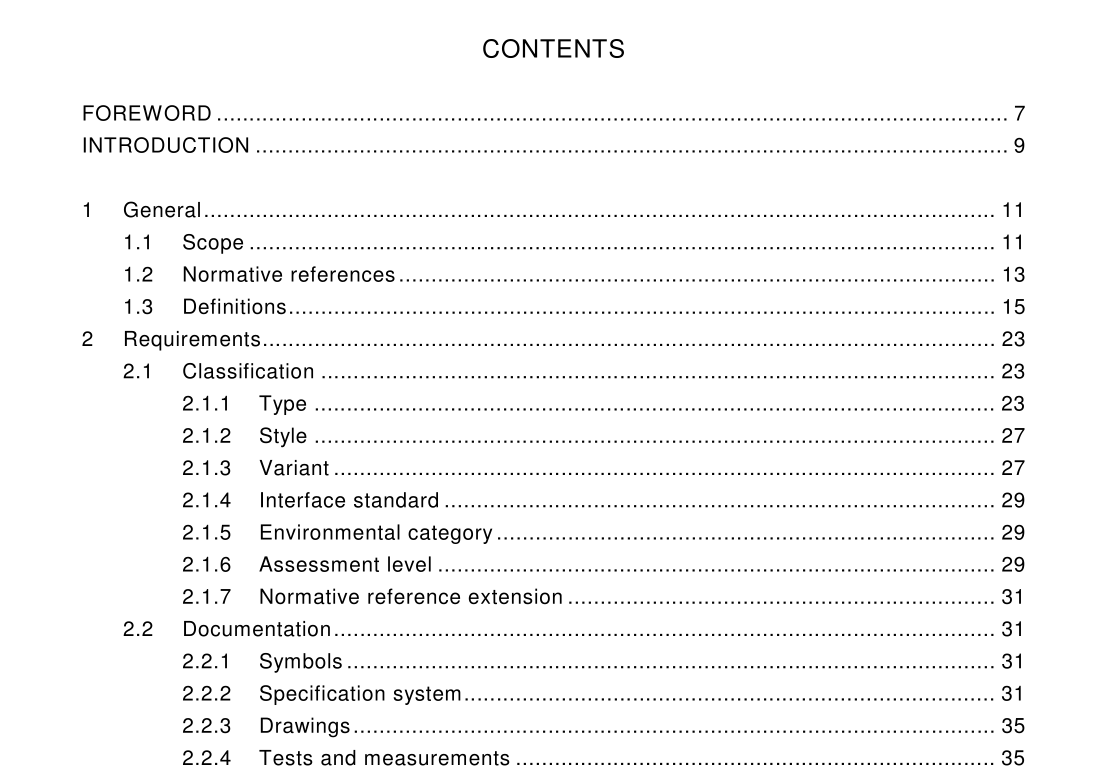IEC 62099 pdf download

IEC 62099 pdf download.Fibre optic wavelength switches – Generic specification
1 General
1.1 Scope
This International Standard applies to fibre optic wavelength switches. The term “fibre optic wavelength switch” can be used to describe a wide range of devices, assemblies and systems both active and passive. Therefore, it is necessary to elaborate on the scope and object of this standard. This specification is intended to cover those devices and assemblies which have the following attributes. – While the switch actuation means is by necessity active, the optical paths through the switch are passive. Thus, neither optical amplification nor opto-electronic conversion is encompassed. – The switch function is restricted to the routing of light rather than intentional power division plus routing. Thus, signal broadcast functions are not encompassed. – They have two or more ports for the transmission of optical power and have two or more states in which power may be routed or blocked between these ports. – The ports are optical fibres or optical fibre connectors. Wavelength switching normally involves separation of the individual wavelength streams of light which are re-routed and then recombined. Thus, wavelength switches may involve multiple optical junctions and multiple-stage switching layouts interior to the switch. However, the specifications relate to the optical performance from port to port of the overall assembly.System control and monitoring with their related electronics and software are not covered by this specification. The switch assembly may have optical means to facilitate such functionality (such as optical taps or wavelength monitoring means), but any related degradation in switch performance should be covered by the overall switch specifications. This specification deals with switches that incorporate passive optical paths, and, therefore, it may be assumed that the signal performance, other than through attenuation, is independent of the signal format. However, particularly in the case of wavelength switching, some technologies for switching and for wavelength discrimination may have an influence on the signals being carried on the channels. Some factors that must be considered are: spatial crosstalk, crosstalk in the wavelength domain, and polarization effects.
1.3 Definitions
For the purposes of this International Standard, the definitions given in IEC 60050(731) apply, together with the following definitions. 1.3.1 optical switch passive component possessing one or more ports which selectively route or block optical power in an optical fibre transmission line 1.3.2 wavelength switch switch which is designed to operate in two or more defined wavelength bands of operation and which can selectively route or block light in one or more of the bands of operation as a function of the wavelength band 1.3.3 port optical fibre or optical fibre connector attached to a passive component for the entry and/or exit of optical power 1.3.4 switch state particular optical configuration of a switch, whereby optical power is transmitted or blocked between specific ports in a predetermined manner 1.3.5 actuation mechanism physical means (mechanical, electrical, acoustic, optical, etc.) by which a switch is designed to change between states 1.3.6 actuation energy input energy required to place a switch in a specific state 1.3.7 transfer matrix optical properties of a fibre optic switch which can be defined in a n × n matrix of coefficients ( n is the number of ports) NOTE The T matrix represents the on-state paths (worst-case transmission), and the T° matrix represents the off- state paths (worst-case isolation). Normally, there is a separate transfer matrix for each defined wavelength band of operation.1.3.20 bounce time elapsed time for the insertion loss between two specified ports of a switch to reach and remain within 0,5 dB of its steady-state value from the moment when it initially reaches within 0,5 dB of the steady-state value 1.3.21 switching time matrix matrix of coefficients in which each coefficient S ij is the longest switching time to turn path ij on or off from any initial state 1.3.22 blocking blocking and various degrees of non-blocking operation functionality are encompassed by this specification NOTE “Blocking” refers to the inability to establish a connection from a free input port to a free output port due to the existence of some other established connection. “Strict-sense non-blocking” refers to a switch matrix in which it is always possible to establish a connection between any free input port and any free output port irrespective of previously established connections. “Wide-sense non-blocking” refers to a matrix in which it is always possible to establish a desired connection provided that some systematic procedure is followed in setting up connections. Some multistage switching architectures fall into this category. “Rearrangeably non-blocking” refers to a switch matrix in which any free input port can be connected to any free output port provided that other established connections are unconnected and then reconnected as part of making the new connection.









